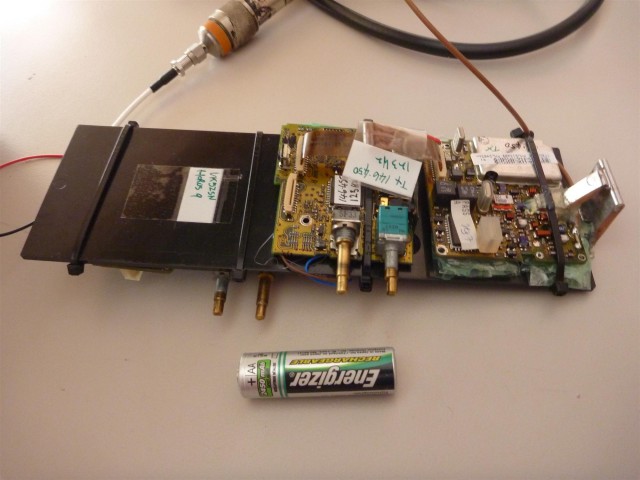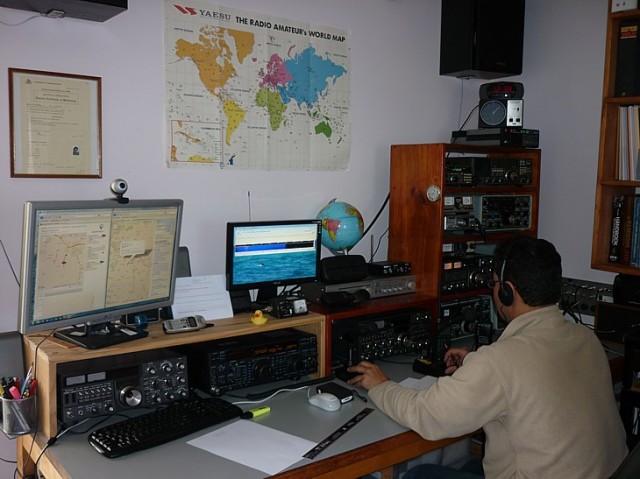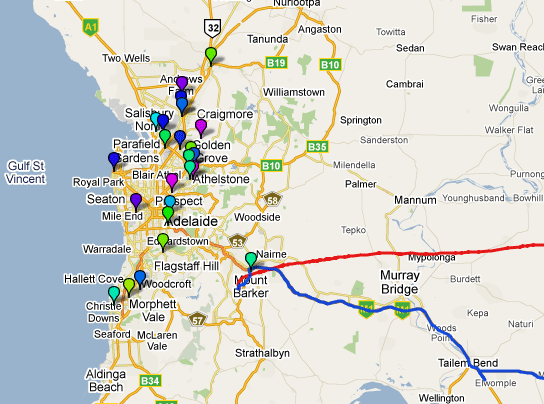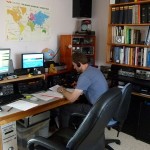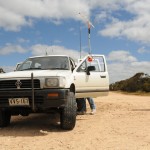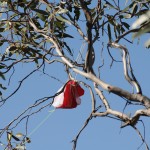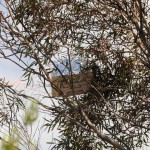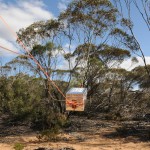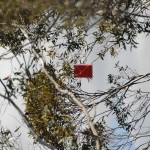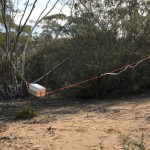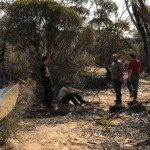Horus 9
Technical information:
| Launch date | 23/10/2010, 12:30pm |
| Landing date | 23/10/2010, 7:00pm |
| Flight duration | ~ 3.5 hours |
| Launch site | -35.1018, 138.8248 |
| Landing site | -34.9169,140.2903 |
| Flight path | Web, KMZ |
| Distance travelled |
135 km |
| Maximum altitude | 34,205 m |
| Average ascent rate | 3m/s |
| Impact speed | 6 m/s (22 km/h) |
| Flight computer | Nut 1.1 flight computer |
| GPS module | Falcom FSA03 |
| Radio transmitter | Radiometrix NTX2 25mw |
| Other payloads |
Cross band talk-through repeater, Simplex parrot repeater |
| Telemetry | 300 baud RTTY, CRC16 checksum, APRS beacon |
| Tracking | Ground stations (distributed listener), 3 chase cars, web based tracker |
Details:
Horus 9 was a launch of a talk through cross band repeater designed to coincide with the WIA National Field Day - the aim of which was to promote awareness of amateur radio amongst the general public. As part of the field day, ham radio operators were setting up stations in public places & putting on demos to demonstrate some of the technology used by radio amateurs. The hope was that the talk through repeater would provide coverage over a radius of upto 800km, allowing many stations to receive it and make contacts, as well as demonstrate the tracking of the balloon in realtime using both the APRS network and our onboard telemetry.
The cross band repeater was made from two old Motorola GP68 commercial radios which had been stripped down to circuit board level and connected back to back - it was put together by Adrian VK5ZSN in an afternoon less than a week before launch.
Horus 9 was also flying the simplex repeater which had previously flown on Horus 6 - this had proven itself to be a great success, and it was decided that this would be used by the chase team, tracking station & flight control - we expected the talk through repeater to be pretty busy!
Matt VK5ZM had been busily working away on an APRS beacon to fly. With the blessing of Adelaide's APRS network operator (Tony VK5AH), the APRS beacon was configured for an update interval of 30 seconds - with the altitude involved and the many digipeaters we'd be hitting, it was possible that this quick update rate could turn the APRS network into somewhat of a packet storm. Fortunately this didn't seem to occur! ![]()
Launch:
Launch conditions for Horus 9 were acceptable, but not ideal - there was a moderate wind, and it was rather overcast. Having learned our lesson from Horus 8 (when we accidentally allowed some helium to escape from our balloon), the balloon fillers for the day (Alan and Adrian) were very careful & got the job done with no mishaps.
Our 4 payloads required some spatial diversity along the balloon train to minimise the effects of intermodulation and desensitisation - as a rule of thumb, we like to put 10 wavelengths between RF payloads. All up, this meant out balloon train was around the 120m mark (they've just been getting longer and longer of late!), which proved rather difficult to launch in the windy conditions.
Despite our best efforts, the last payload on the balloon train (the simplex command repeater) dragged along the around as the balloon was launched, and ended up swinging into a wooden fence post, where it tangled & prevented the balloon from taking off. I quickly hopped the fence to the paddock, freeing it from the barbed wire fence & letting it free - for a few moments it looked as though the payloads might not clear some trees in the distance, but luckily no further tangling occurred! However, it became evident at this point that the simplex repeater was not working - it wouldn't respond & was not beaconing as it should have been. Whilst not a show stopper, this was disappointing.
Flight:
Within a few minutes of launch we were able to hear our control station (some 40km away) coming in on the talk through repeater. The repeater was very clear on our end, and signal reports from the other end were good too.
20 minutes after the balloon was up, we noticed that we could hear the simplex repeater beaconing once more. We're not sure what happened, but it appeared to have come back online, so the team switched back to it and gave it a bit of a workout.
An hour or so into the flight, the batteries on the simplex repeater gave up the ghost - we were testing LiPo batteries in this payload, which didn't quite give us the performance we'd hoped for. Fortunately the talk through repeater was using lithium primary cells which showed no signs of slowing down, despite the very high duty cycle!
Repeater coming online:
Some of the contacts logged:
Throughout the course of the flight, the crossband repeater got a heavy workout, with 59 contacts being logged from South Australia, Victoria & even New South Wales.
Recovery:
As the flight progressed, it became clear that the payload was very likely to land in Billatt Conservation park - a large expanse of untouched scrub with very few access roads. Adrian & his team decided to enter the park in his landcruiser, while Matt and I decided that we'd place ourselves on the western edge of the park, in case the payload ended up avoiding the park.
Balloon burst:
As luck would have it, the payload ended up landing very close to the North-West corner of the park. Roads in this area were not great, but we were able to get within a couple of kilometres of the landing site - from there it was a bit of a walk through the scrub to recover everything.
Alan and I arrived at the site first, closely followed by Matt, Grant and Scott. Adrian and his team were still some distance away due to their longer route - getting bogged in thick clay didn't help things either!
Conclusions:
Horus 9 was a great launch - all of our payloads performed as we'd hoped, with the exception of the batteries in the parrot repeater. The APRS beacon was a great success, with almost every frame successfully making it into the network - Matt has plans to miniaturise the beacon and extend it's capabilities, something which I'm looking forward to.
The talk through repeater seemed to be a hit with the amateur radio community, and a great number of contacts were logged. However, in our planning of the frequencies, we overlooked a harmonic relationship between the input and output frequencies, which may have slightly decreased our performance. We also found that a few users had issues working the repeater, with the most common problems being feedback (from multiple radios), lack of CTCSS tones & over-deviated CTCSS tones.
Overall though, we're very happy with how everything went - a big thanks to everybody who helped us make this launch as successful as it was! ![]()
Pictures:
